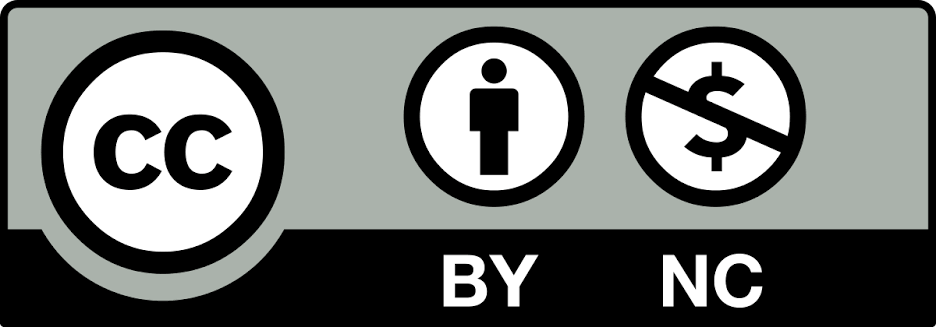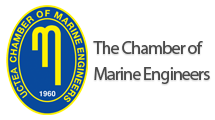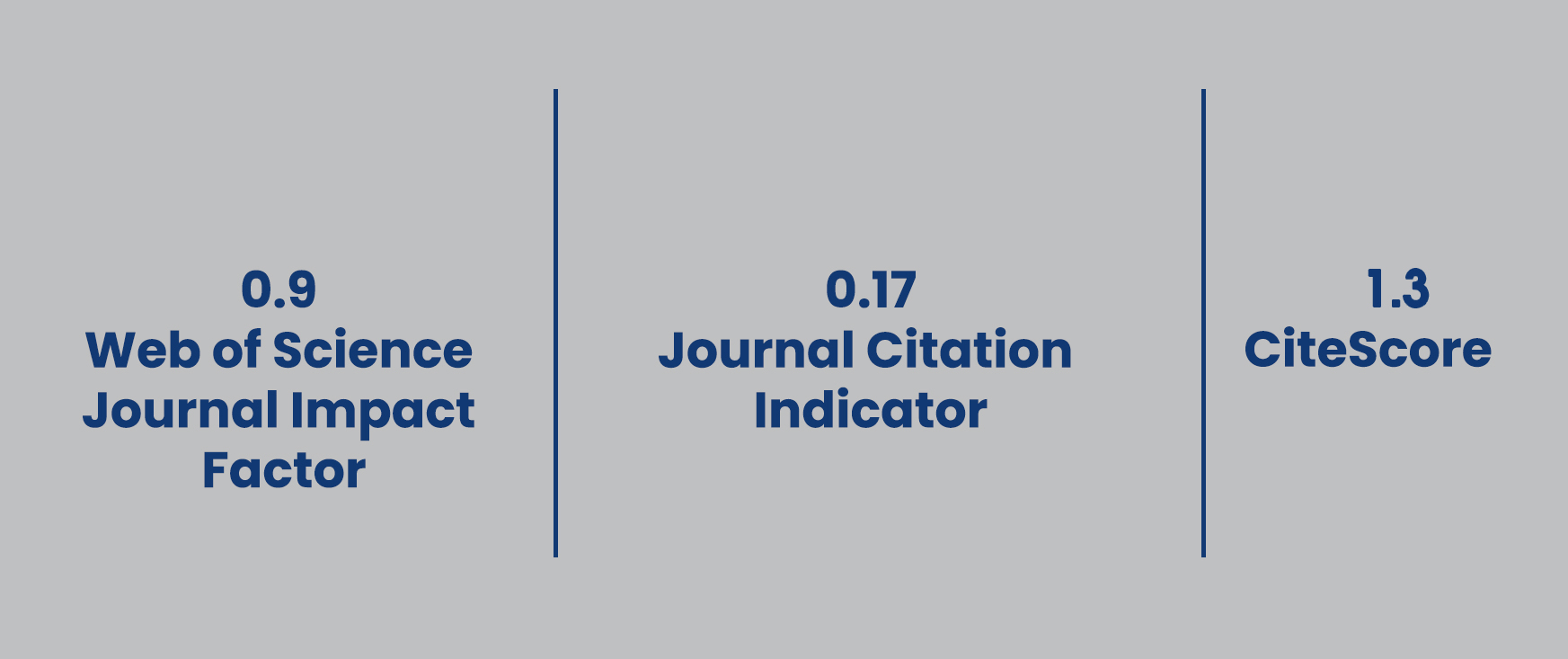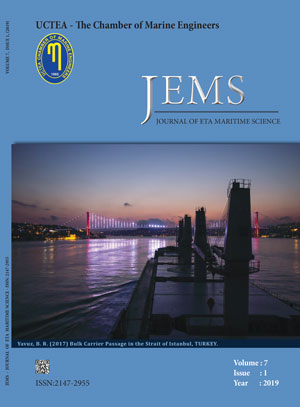

JEMS apply the Creative Commons Attribution NonCommercial 4.0 International Licence to all manuscripts to be published
ABSTRACTING & INDEXING
Volume: 7 Issue: 1 - 2019
| 1. | Editorial doi: 10.5505/jems.2019.83713 Pages 1 - 2 Abstract | |
| 2. | Journal of ETA Maritime Science (Volume: 7 Issue: 1, 2019) Pages 1 - 96 Abstract | |
| ORIGINAL RESEARCH (AR) | |
| 3. | Route Prioritization by using Fuzzy Analytic Hierarchy Process extended Dijkstra Algorithm Bekir Şahin doi: 10.5505/jems.2019.39306 Pages 3 - 15 Seyir planlaması, yakıt tüketimi, zaman ve emniyet faktörleri açısından önem arz etmektedir. Uygun rotanın belirlenmesi, birçok kriterin aynı anda gözden geçirilmesini gerektirdiği için gemi yönetiminde uzmanlık gerektiren konulardan biridir. Bu çalışmanın amacı, bulanık analitik hiyerarşi süreci (BAHS) ile genişletilmiş Dijsktra algoritması geliştirmek ve deniz çevresinde en öncelikli rotalama problemini araştırmaktır. Literatürde Dijsktra algoritması ile ilgili birçok çalışma bulunmaktadır fakat bu çalışmalar çoklu karar vericiler, karar matrislerinin tutarlılık kontrolü ve fayda ya da masraf şeklinde olabilecek çoklu kriterlerden yoksundur. Bu modelde, öznel yargılamalar ve kişisel tecrübeler karar verme sürecine doğrudan dahil olmaktadır. Amaçlaman BAHS ile genişletilmiş Dijsktra algoritması (bundan sonra BAHS-Dijsktra) bulanıklığın mevcudiyetindeki belirsizliği elleçleme yeteneklerini geliştirmektedir. Bu çalışma, insanlı yada insansız gemilere yeni bir rota optimizasyon algoritması sunarak yakıt tüketimi, zaman ve emniyet faydası sağlanması amaçlanmıştır. Seyir planlaması, yakıt tüketimi, zaman ve emniyet faktörleri açısından önem arz etmektedir. Uygun rotanın belirlenmesi, birçok kriterin aynı anda gözden geçirilmesini gerektirdiği için gemi yönetiminde uzmanlık gerektiren konulardan biridir. Bu çalışmanın amacı, bulanık analitik hiyerarşi süreci (BAHS) ile genişletilmiş Dijsktra algoritması geliştirmek ve deniz çevresinde en öncelikli rotalama problemini araştırmaktır. Literatürde Dijsktra algoritması ile ilgili birçok çalışma bulunmaktadır fakat bu çalışmalar çoklu karar vericiler, karar matrislerinin tutarlılık kontrolü ve fayda ya da masraf şeklinde olabilecek çoklu kriterlerden yoksundur. Bu modelde, öznel yargılamalar ve kişisel tecrübeler karar verme sürecine doğrudan dahil olmaktadır. Amaçlanan BAHS ile genişletilmiş Dijsktra algoritması (bundan sonra BAHS-Dijsktra), belirsiz kıstasları ele alma yeteneklerini, bulanıklığın varlığında geliştirmektedir. Bu çalışma, insanlı yada insansız gemilere yeni bir rota optimizasyon algoritması sunarak yakıt tüketimi, zaman ve emniyet faydası sağlanması amaçlanmıştır. |
| 4. | Risk Based Sea Ambulance Design Ayhan Mentes, Can Berk Koç, Deniz Öztürk, Gürbüz Bilici, Emre Güven, Yağmur Baki, Eşref Kırçiçeği doi: 10.5505/jems.2019.02418 Pages 17 - 32 Denizde, güvenliği en üst düzeye çıkarmak için risk faktörlerini modellemek ve risk tabanlı tasarım araçlarını kullanmak önemlidir. Güvenliği arttırmak ve müşteri taleplerini karşılamak için etkin risk modelleme teknikleri ve karar verme araçlarının geliştirilmesi ve uygulanması gerekmektedir. Bu çalışmada, mevcut bir deniz ambulans teknesi operasyon riskleri incelenmiş ve mevcut tekne risk tabanlı bir yaklaşımla yeniden tasarlanmıştır. Risk değerlendirmesi ve model tasarımında, Hata Türü ve Etki Analizi (FMEA) kullanılmış ve risk öncelik sayıları (RPNs) hesaplanmıştır. Bu çalışmadan elde edilen sonuçlar, deniz ambulans teknelerinin güvenliğini arttırmaya ve potansiyel risklerin önlenmesine veya azaltılmasına katkıda bulunacaktır. To maximize safety at sea, modelling of risk factors and use of risk based design tools is significant. Effective risk modelling techniques and decision-making tools need to be developed and applied to increase safety and meet customer demands. In this study, the operational risks of an existing ambulance boat were examined and the existing boat was redesigned as a risk-based approach. Failure Mode and Effects Analysis (FMEA) was used and risk priority numbers (RPNs) were calculated in the risk assessment and redesign. The results obtained from the study will contribute to improving the safety of ambulance boats and preventing or mitigating of potential risks. |
| 5. | Numerical Investigation of 2-D Wave Making Characteristics of a Submerged Hydrofoil Murat Ayyıldız, Ahmet Ziya Saydam, Murat Özbulut doi: 10.5505/jems.2019.50362 Pages 33 - 41 Bu çalışmada, serbest su yüzeyine yakın bir hidrofoil etrafındaki akış, yani 2 boyutlu dalga yapımı problemi sayısal olarak incelenmiştir. Deney sonuçları farklı derinlikler ve akış hızlarında RANS hesaplamalı akışkanlar dinamiği kodu ve interpolasyonlu parçacık hidrodinamiği(İPH) yöntemi ile karşılaştırılmıştır. Sayısal yaklaşımların serbest su yüzeyi deformasyonunun tahmini açısından kabiliyetleri değerlendirilmiştir. Özellikle yüksek Froude sayılarında, indüklenen dalga profillerinin, her iki sayısal yöntemde de yüksek mertebede zamana bağlı (kararsız) bir doğası olduğu gözlemlenmiştir. Sayısal analizden elde edilen basınç hatları da birbiriyle karşılaştırılmıştır. Sayısal çözüm teknikleri açısından gelişimini büyük ölçüde tamamlamış RANS yönteminin sonuçları ile görece yeni sayılabilecek ve halen gelişimini devam ettirmekte olan İPH yönteminin sonuçları arasındaki uyumluluğun gelecek araştırma çalışmaları açısından ümit verici olduğu görülmüştür. In this study, 2-D wave making characteristics of a submerged hydrofoil has been investigated in a numerical fashion. Experimental data available for different depths of submergence and flow velocities have been compared to the results obtained by a commercial RANS CFD code and an in-house SPH code. The capabilities of the numerical approaches in terms of capturing the free surface deformation have been assessed. At high Froude numbers, the induced wave profiles have been observed to exhibit an unsteady nature by both numerical methods. The pressure contours obtained from the numerical analysis have also been compared with each other. It has been seen that the agreement between the results of the well-established RANS method and recently progressing SPH technique is encouraging for further development. |
| 6. | Energy and Exergy Analyses of a Bulk Carrier Diesel Generator for Different Loads Görkem Kökkülünk doi: 10.5505/jems.2019.03264 Pages 43 - 50 Enerji, sistemlerin iş yapabilme yeteneğidir. Ekserji ise bu enerjinin kullanılabilirliği veya yapılabilecek maksimum iş olarak tanımlanır. Bu çalışmada turbo dolduruculu bir gemi dizel jeneratörünün %25, %50, %75 ve %100 yük şartları için enerji, ekserji ve atık ısı analizi yapılmıştır. Yapılan enerji ve ekserji hesaplamaları sonucunda motorun %25, %50, %75 ve %100 yük koşullarına göre I. ve II Kanun verimleri sırasıyla %34,29, %39,69, %42,01, %42,49 ve %38,36, %44,38, %46,8 ve %47,04 olarak hesaplanmıştır. Maksimum şaft gücü değerleri, motorun en çok çalıştırıldığı %50 ve %75 yükler için sırasıyla 744,1 kW ve 1058,2 kW dir. Kullanılabilir enerji yani ekserji değerlerine bakıldığında ise en yüksek potansiyelin maksimum yükte 55,7 kW ile egzoz gazında ve maksimum yükte 160,9 kW ile soğutma suyunda olduğu tespit edilmiştir. Çevreden ve yağlama yağından geri kazanılabilecek ekserji değerleri ise yadsınamayacak kadar büyüktür. Energy is the ability to do work of the systems. Exergy is defined as the availability of energy or the maximum work to be done. In this study, energy, exergy and waste heat analyses of a turbo charged marine diesel generator is conducted for the loads of 25%, 50%, 75% and 100%. As a result of energy and exergy analysis, the first and second law efficiencies of a engine at 25%, 50%, 75% and 100% load conditions are calculated as 34.29%, 39.69%, 42.01%, 42.49% and 38.36%, 44.38%, 46.8% and 47.04%, respectively. The maximum shaft power values are 744.1 kW and 1058.2 kW for 50% and 75% loads, respectively. Considering the exergy values which means the available energy, the highest potentials are found as 55.7 kW at maximum load in the exhaust gases and 160.9 kW at maximum load in the cooling water. The exergy values that can be recovered from the surrounding and lubricating oil are big enough not to be neglected. |
| 7. | Revealing Marketing Criteria of Customs Services: A Dyadic Approach İlkyaz İldeş, Aysu Göçer doi: 10.5505/jems.2019.55376 Pages 51 - 63 The increasing importance of marketing services has led services industries to pursue ways of providing better services and improve customer satisfaction in a competitive marketplace. Knowing what can be promoted and what customers consider in choosing the service provider are important factors in a strategic marketing plan. Recognizing core competences with customer expectations and perceptions is undoubtedly the best tool for success. While services marketing has been studied for many services industries, logistics, particularly customs services, is rarely addressed. Exploiting services quality and perception scales, this qualitative study applied content analysis to semi-structured interviews to explore the marketing criteria of customs service providers from a dyadic perspective within business-to-business (B2B) services. Marketing criteria for customs services were categorized as company, personnel and service-oriented. Three genuine dimensions were created in accordance with their relevance to the service provider company, employees working in the service provider company and the service itself. The results reveal that customs services marketing criteria taken into consideration by customers for service provider choice can be different when compared to other services within B2B environment. This study contributes to services marketing regarding customs services by comparing the factors of logistics services quality and perception literature. |
| 8. | A Comparison Of Third Party And FullL In-House Management Based On Shipping Performance Indexes In Turkish Coaster Management Mehmet Keleş, Serdar KUM doi: 10.5505/jems.2019.32154 Pages 65 - 77 Koster taşımacılığı olarak tanımlanan yakın kıyısal sefer yapan küçük tonajlardaki gemiler ile (1000-12000 DWT arası) yapılan ticaret yıllar boyu Türk denizcilik sektörüne katkıları ile hem ülke deniz ticaretinin en önemli unsuru hem de bir üst seviye olan, daha büyük tonajlı gemi sahibi olma yolunda atılan ilk adımı oluşturmuştur. Üçüncü taraf gemi yönetimi ise sürekli değişen ve gelişen denizcilik sektöründe rekabet üstünlüğü sağlayabilmek için her tipten, çeşitli ölçeklerde şirketler tarafından son yıllarda kullanımı giderek artan bir hizmet türüdür. Bu çalışma; BIMCOnun Gemicilik KPI Standartları V3.0 kullanılarak, yönetiminde dış kaynak kullanılan koster gemileri ile yönetim işini kurum içi örgütlenme yoluyla kendileri üstlenen gemi sahiplerinin, yönetimi altında bulunan gemilerin sergiledikleri performanslar arasında anlamlı bir fark bulunup-bulunmadığının belirlenmesi amacıyla tarama modeli şekli olan ilişkisel araştırma yöntemi kullanılarak gerçekleştirilmiştir. Araştırma sonucunda elde edilebilen SPI değerlerinin çözüm ve yorumlanmasında; gemilerin performansları arasında fark olup-olmadığını tespit etmek için One Way Anova (tek yönlü varyans analizi) testi kullanılmıştır. Araştırmanın sonunda iki farklı yönetim şekliyle yönetilen gemilerin performansları arasında anlamlı bir fark olduğu tespit edilmiştir. The trade with its contribution to Turkish maritime industry, named as coaster transportation, operated by near coastal voyages by means of low-tonnaged ships (1000-12000 DWT), has been both the backbone of Turkish maritime industry and the first step in owning bigger sized ships which is an upper level in the industry. Third party ship management is a service which has been used more often recently by all types and scales of companies to take competitive advantage in steadily changing and improving maritime industry. This study has been held by correlational research method which is a survey research model, for the purpose of identifying if there is a statistically significant difference between the ships fully managed by third party ship management companies and fully in-house managed ships by using BIMCOs Key Performance Indicator Standards V3.0. One way Anova (one way variation test) is used in analysing and evaluating the SPI values to to find out if there is a statistically significant difference among companies. At the end of the study, it is found that there is a statistically significant difference between the performances of two different ways managed ships. |
| 9. | The Effect of Organizational Attitudes and Behaviours on Job Performance in Maritime Transportation Sector Employees Murat YORULMAZ doi: 10.5505/jems.2019.48379 Pages 79 - 96 Örgüt içindeki temel unsurlardan biri olan insan kaynağı, örgütleri amaçlarına ulaştıran en etkili ve önemli kaynaklar arasındadır. Dolayısıyla insan kaynağının iyi yönetilmesi örgütlerin başarısının da ön koşuludur. Bu nedenle de çalışanların örgütlerine ve işlerine yönelik tutum ve davranışlarının anlaşılması ve yönetilmesi önemli bir olgu olarak kabul edilmektedir. Bu çalışmanın amacı, yöneticilerin yakından ilgili olduğu örgütsel tutum ve davranışlardan; iş tatmini ile örgütsel vatandaşlık davranışlarının, bireysel iş performansına olan etkisini, feribot ve deniz otobüslerinde çalışan gemi adamları örnekleminde incelemek ve gemi adamlarının çalıştıkları bölümlere göre, söz konusu örgütsel tutum ve davranışlarda anlamlı farklılıklar olup olmadığını ortaya çıkartmaktır. Anket yöntemiyle yapılan çalışmada 726 gemi adamından elde edilen verilerin analizi sonucunda, aralarında anlamlı ilişkiler bulunan iş tatmini ve örgütsel vatandaşlık davranışının, bireysel iş performansını pozitif yönde etkilediği ve iş tatmini ile iş performansı arasındaki ilişkide örgütsel vatandaşlık davranışının kısmi ara değişken etkisinin olduğu tespit edilmiştir. Diğer taraftan güverte, makine ve yardımcı hizmetli sınıfı gemi adamları arasında, örgütsel vatandaşlık davranışları ve iş performansı açısından istatistiksel anlamda anlamlı farklılıklar olduğu saptanmıştır. Human resources, which is one of the fundamental elements in the organization, is among the most effective and important sources that bring the organizations to their goals. Therefore, good management of human resources is a prerequisite for the success of organizations. Therefore, understanding and managing the attitudes and behaviors of employees towards their organizations and businesses is considered an important phenomenon. The aim of this study is to examine the organizational attitudes and behaviors that managers are closely related to examine the effects of job satisfaction and organizational citizenship behaviors on individual work performance in the sample of the seafarerers working in the ferry and sea buses and to find out whether there are any significant differences in the organizational attitudes and behaviors according to the departments of the seafarerers. As a result of the analysis of the data obtained from 726 seafarers, it was determined that job satisfaction and organizational citizenship behavior, which had significant relations between them, had a positive effect on individual job performance and that the organizational citizenship behavior had a partial mediator variable effect in the relationship between job satisfaction and job performance. On the other hand, there were statistically significant differences in terms of organizational citizenship behaviors and job performance between deck, engine and auxiliary servicemen seafarers. |









